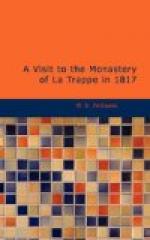Rennes is the chief city of the Isle-et-Vilaine, and in former times was the capital of Bretagne. It is a large ancient built town, standing on a vast plain, between the rivers Isle and Vilaine. It has a hall of justice, (Cour Royale,) an episcopal palace, and a foundry for cannon. A more dismal dirty looking city, or a more uninteresting one to a stranger, is seldom to be seen. Few traces remain of its ancient splendor; the old rampart, which once encompassed it, now forms a promenade.
Its commerce is considerable, being the entrepot for grain and cattle, with which it supplies Paris and the Southern Provinces, not so abundant in their produce. Jane of Flanders, Countess of Montfort, the most extraordinary woman of her time, resided here, during the imprisonment of her husband in the palace of the Louvre, by Philippe de Valois,[5] when Edward the Third of England invaded France. Hennebon, when attacked by Charles of Blois, was defended by the Countess, and relieved by Sir Walter Manny, whom Edward had sent with a body of 6,000 archers to her succour. The garrison, encouraged by so rare an example of female valour, defended themselves against an immense army, composed of French, Spaniards, Genoese, and Bretons, who frequently assaulted it, and were as vigorously repulsed. On one occasion, Froissart mentions her sallying out at the head of a body of two hundred cavalry, throwing the enemy into great confusion, doing great execution among them, and setting fire to the tents and magazines, which were entirely destroyed.
[Footnote 5: Among the brave knights who engaged in so many battles and perilous adventures, and other feats of arms, Froissart mentions Philip, as opposed to those heroes of high renown, Edward of England, the Prince of Wales his son, the Duke of Lancaster, Sir Reginald Lord Cobham, Sir Walter Manny of Hainault, Sir John Chandos, Sir Fulk Harley, and many others recorded in his book for worth and prowess. “In France also was found good chivalry, strong of limb and stout of heart, and in great abundance, for the kingdom of France was never brought so low as to want men ever ready for combat. Such was King Philipe de Valois, a bold and hardy knight, and his son King John, also John king of Bohemia, and Charles Count of Alencon his son".]
The population of Rennes is 27,000. It is at present garrisoned by one thousand troops, and people are of opinion that government finds it no easy task to keep down the spirit of the Vendeans, who are said to be, “plus Royalistes que le Roi”. There appears every where a strong spirit of dissatisfaction on the part of the Royalists, at the general preference given to those who were employed under the late ruler in places of public trust, and who were avowed enemies to the restoration of Louis XVIII.
CHAP. IV.
ROUTE FROM RENNES TO NANTES. CITY OF NANTES. HISTORICAL ANECDOTES.




